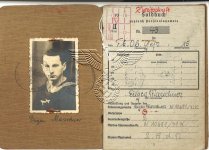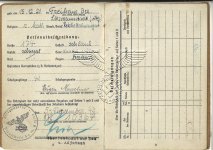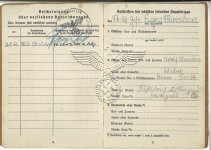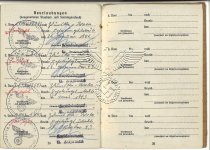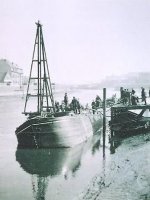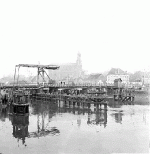Hello Guys,
This time I'll show one of my Kriegsmarine Soldbucher, less spectacular then the SSLAH example I recently posted but nevertheless an interesting piece with an interesting background story.
Eugen Marschner (°1921) was an office worker for the railroad from Litzmannstadt (before the German occupation of Poland this city was known as Lodz); it isn't completely obvious from the Soldbuch but it seems that he was a Volksdeutscher, an ethnic German in Poland, his father was a weaver in this textile town.
In November '43 he got a replacement Soldbuch and for this point we go further with his story.
Eugen Marschner was an Obergefreiter with 36.Minensuchflottille, 36th minesweeper flotilla; this naval unit was based in the Ostend harbor and mainly equipped with converted Belgian and Dutch fishing boats and their task was to keep the parts of the Northsea and Channel free from mines so that German merchant and war fleet could safely pass through it.
It is remarkable that with their obsolete vessels were able to successfully operate in these waters; his commanding officer, K.Blasberg was in December '43 awarded the German Cross in Gold and in September '44 a Knights Cross.
Also Eugen Marschner participated in these dangerous operations and on August 23 1943 he was awarded the Minensuchabzeichen, the minesweepers badge.
At the end of August 1944 the allies liberate Paris and move fast towards Belgium driving the beaten German forces in front of them, on September 2 '44 the Belgian border is crossed and the next day Brussels is liberated.
Also the German navy decides to abandon his bases on the Belgian coast; in the Ostend harbor they load up a barge, the MS Aligator, the plan is to evacuate their equipment to Hamburg (Germany) through the canals, the barge will be protected by an armed yacht, a dangerous plan because the allies are pushing through Belgium in record speed.
The first stage is to sail on the canal from Ostend to Bruges and then to Ghent, from there on the Scheldt river to Antwerp; on September 4 1944 at a proximally 16.00 the small convoy reaches the Scheldt river bridge in Wetteren.
This bridge is closed and partially damaged by German engineers in an attempt to blow it up, the sailors of the armed yacht disembark and open the bridge and the small convoy continues his journey, all this is observed by members of the Belgian resistance and a British recon soldier; when the barge passes the bridge they open fire, hundred meters further their is a bend in the river and their the barge strands, the resistance members now assault the barge.
In this fight several German sailors are WIA and one gets KIA, the one that is killed is Eugen Marschner, his remains will be brought to the local hospital and be buried the next day in the German war cemetery in Kwatrecht.
After the war when all German soldiers buried in Belgium are relocated to the big war cemetery in Lommel an administrative mistake is made and Eugen Marschner now rests in an unknown grave.
You'll notice that a Kriegsmarine Soldbuch contains less details then Soldbucher from other army branches.
Cheers,
Peter
This time I'll show one of my Kriegsmarine Soldbucher, less spectacular then the SSLAH example I recently posted but nevertheless an interesting piece with an interesting background story.
Eugen Marschner (°1921) was an office worker for the railroad from Litzmannstadt (before the German occupation of Poland this city was known as Lodz); it isn't completely obvious from the Soldbuch but it seems that he was a Volksdeutscher, an ethnic German in Poland, his father was a weaver in this textile town.
In November '43 he got a replacement Soldbuch and for this point we go further with his story.
Eugen Marschner was an Obergefreiter with 36.Minensuchflottille, 36th minesweeper flotilla; this naval unit was based in the Ostend harbor and mainly equipped with converted Belgian and Dutch fishing boats and their task was to keep the parts of the Northsea and Channel free from mines so that German merchant and war fleet could safely pass through it.
It is remarkable that with their obsolete vessels were able to successfully operate in these waters; his commanding officer, K.Blasberg was in December '43 awarded the German Cross in Gold and in September '44 a Knights Cross.
Also Eugen Marschner participated in these dangerous operations and on August 23 1943 he was awarded the Minensuchabzeichen, the minesweepers badge.
At the end of August 1944 the allies liberate Paris and move fast towards Belgium driving the beaten German forces in front of them, on September 2 '44 the Belgian border is crossed and the next day Brussels is liberated.
Also the German navy decides to abandon his bases on the Belgian coast; in the Ostend harbor they load up a barge, the MS Aligator, the plan is to evacuate their equipment to Hamburg (Germany) through the canals, the barge will be protected by an armed yacht, a dangerous plan because the allies are pushing through Belgium in record speed.
The first stage is to sail on the canal from Ostend to Bruges and then to Ghent, from there on the Scheldt river to Antwerp; on September 4 1944 at a proximally 16.00 the small convoy reaches the Scheldt river bridge in Wetteren.
This bridge is closed and partially damaged by German engineers in an attempt to blow it up, the sailors of the armed yacht disembark and open the bridge and the small convoy continues his journey, all this is observed by members of the Belgian resistance and a British recon soldier; when the barge passes the bridge they open fire, hundred meters further their is a bend in the river and their the barge strands, the resistance members now assault the barge.
In this fight several German sailors are WIA and one gets KIA, the one that is killed is Eugen Marschner, his remains will be brought to the local hospital and be buried the next day in the German war cemetery in Kwatrecht.
After the war when all German soldiers buried in Belgium are relocated to the big war cemetery in Lommel an administrative mistake is made and Eugen Marschner now rests in an unknown grave.
You'll notice that a Kriegsmarine Soldbuch contains less details then Soldbucher from other army branches.
Cheers,
Peter



